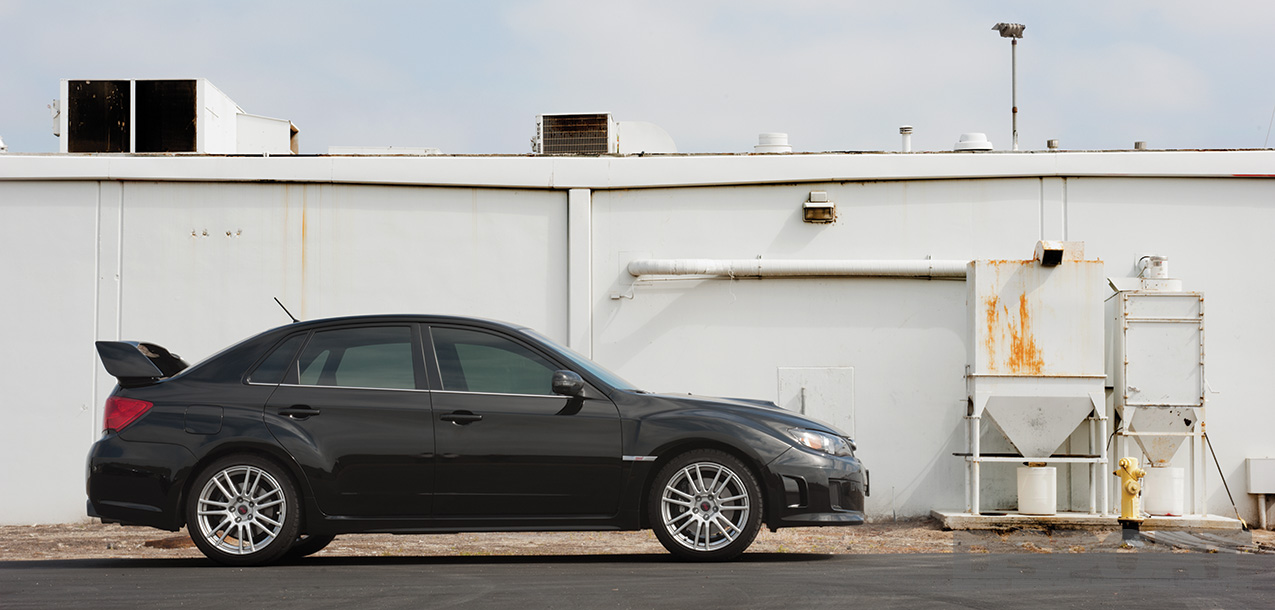The Dyno
Baseline
Our STI made the trek to Crawford Performance in Oceanside, California, to undero “stage zero” upgrades and for fine-tuning of the conservative factory ECU settings. The STI was coupled to Crawford’s Dynapack all-wheel drive dynamometer and registered a baseline rating of 234.4 WHP peaking at 5,210 rpm and a maximum 280.8 lb-ft of torque peaking at 3,600 rpm.
234.4 WHP @ 5,210 RPM
280.8 LB-FT TQ @ 3,600 RPM
Dynapack
Test 1 Oil, Plus, Air/Oil Separator
Our stage zero modifications showed a large gain in the low-to-midrange powerband but stumbled slightly near redline.
232.9 WHP @ 5,060 RPM
288.6 LB-FT TQ @ 3,380 RPM
Test 2 Cobb AccessPORT
The COBB AccessPORT comes with several pre-configured maps for stock and mildly-modified engines with common aftermarket accessories. Crawford Performance’s Bill Knose fine-tuned the provided stock map to even greater power levels.
262.3 WHP @ 5,864 RPM
293.8 LB-FT TQ @ 3,266 RPM
Test 3 AccessPORT + 1.5 lbs Boost
Stock-ECU levels allowed a peak boost of 14.9 psi. Knose’s fuel and ignition map tuning allowed a 0.2psi increase to 15.1psi. After the initial fine-tuning, Knose used the COBB unit to increase the boost to 16.5 psi maximum. This shifted the power curve upwards throughout the powerband.
268.9 WHP @ 6,100 RPM
298.3 LB-FT TQ @ 3,580 RPM
Our STI made the trek to Crawford Performance in Oceanside, California, to undergo “stage zero” upgrades and for fine-tuning of the conservative factory ECU settings. The STI was coupled to Crawford’s Dynapack all-wheel drive dynamometer and registered a baseline rating of 234.4 WHP peaking at 5,210 rpm and a maximum 280.8 lb-ft of torque peaking at 3,600 rpm.
Next, we drained the existing engine oil and removed the factory oil filter and spark plugs. The one-step-colder NGK iridium plugs were torqued into each head and the block received its Royal Purple XPR 5W30 synthetic oil and Extended Life oil filter before Knose installed the Crawford Performance Air Oil Separator. The Crawford unit consists of a canister and several feed and drain lines but installed without a hitch. The subsequent pull on the Dynapack revealed a dramatic 15-to-18 horsepower increase in from 3,100 rpm to 3,600 rpm from the oil and plug replacement. In the upper reaches of the powerband, there was a slight loss of power from about 5,200 rpm 5,700 rpm. The powerband above 5,800 rpm was made less erratic, providing more usable power for the duration of that rpm-range, but lost a few points of peak power at the 6,400 rpm redline to finish at 232.9 WHP. The engine produced more torque at a much earlier rpm range, peaking at 288.6 lb-ft at 3,380 rpm.
With the stage zero parts in place, Knose plugged in the AccessPORT and went to work tweaking the fuel and ignition timing maps. We wanted to see how far the “completely stock” setup could be optimized so the AccessPORT was used to maintain the factory boost setting. Knose’s reconfigured maps shifted the entire powerband upwards and smoothened the erratic midrange power production. The 3,600-to-4,100 range benefitted from 15-to-20 horsepower increases but the powerband above 4,300 rpm is where the retune showed its worth. The tuning eliminated the dramatic power drop at 5,400 rpm and showed gains as high as 45 WHP until redline. Peak power shot up to 262.3 WHP at 5,864 rpm while peak torque increased to 293.8 lb-ft at 3,265 rpm.
With those power numbers in place, Knose allowed the turbocharger to produce an additional 1.5 psi of boost before wastegate opening and again fine-tuned the maps to compensate. The end result was another shift of the entire powerband, with a steady increase of approximately 10-12 horsepower running from 3,600 rpm all the way to the 6,400 rpm redline. Peak torque increased another 4.5 lb-ft while peak power production checked out at 268.9 WHP, an increase of 6.6 WHP.






